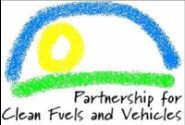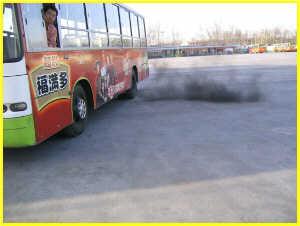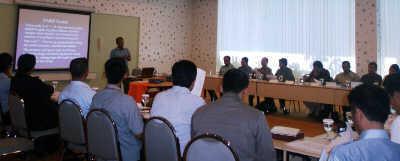Promoting Cleaner Fuels and Vehicles Worldwide
The Partnership for Clean Fuels and Vehicles (PCFV) is a global public-private partnership working with developing and transitional countries to reduce air pollution from vehicles through the promotion of cleaner fuels and vehicles.
EPA was a charter member of the partnership, which began its work in 2002 with the promotion of unleaded fuels. Beginning in 2008, the PCFV’s second goal has been to reduce sulfur in fuels. At that time, no developing countries had low sulfur fuel policies.
The PCFV helped get lead out of gasoline globally, resulting in economic benefits from the prevention of lead exposure in children everywhere. [Reference: Peter L. Tsai and Thomas H. Hatfield. “Global Benefits From the Phaseout of Leaded Fuel.” Journal of Environmental Health. 74: 8-14. 2011.]
Since 2009, the PCFV has helped 23 countries, whose populations total 1.7 billion, implement low sulfur diesel fuel standards (50 ppm or below). This effort has significantly reduced sulfur dioxides and particulate matter, both of which have significant impacts on human health.
The PCFV engages governments and stakeholders in developing countries:
- To eliminate lead in gasoline globally. There are only a few countries left still using only leaded fuels, and several offering both leaded and unleaded fuels. View map displaying countries still using leaded fuels, Exit(1 pp, 4 M, About PDF) courtesy of PCFV.
- For all countries to have access to fuel with 50 ppm sulfur. For comparison, the United States uses 15 ppm sulfur diesel fuel; most developing countries offer fuels that are much higher in sulfur content. View map displaying countries using sulfur in diesel, Exit(1 pp, 4.15 M, About PDF) courtesy of PCFV.
- To promote the introduction of cleaner, more efficient vehicles. Since 2012 six developing countries have adopted vehicle emission standards, and additional countries are using the PCFV regulatory toolkit to develop standards.
View a June 2016 update on progress in the PCFV on these goals: PCFV Achievements May 2014 to May 2016 (PDF): (36 pp, 2.4M, About PDF)
Evaluations, Tools and Outcomes from PCFV’s Work
Click to open the tabs below.
- PCFV Regulatory Toolkit
The Partnership for Clean Fuels and Vehicles (PCFV) has been working with developing and transitional countries to reduce vehicular air pollution through the promotion of cleaner fuels and vehicles. Now, with support from EPA and Environment Canada, it has created a new regulatory toolkit to introduce the need for a systems approach to vehicle emission reduction. A systems approach matches fuels and vehicle improvements - to move towards tighter vehicle emissions regulations.
This toolkit will support developing and transitional countries to introduce requirements for 50 ppm and below sulfur fuels; produce or import lower emitting and more efficient vehicle technologies; establish vehicle emissions control roadmaps; and ultimately improve air quality and human health in these countries.
- Promoting Cleaner Fuels in Indonesia
EPA is working through the PCFV to enable the production of cleaner fuels in Indonesia. Since 2010, EPA has worked with Indonesia to develop cost-benefit analyses to promote government fiscal policies, to create and foster dialogue amongst a cross-government and industry stakeholders group, and to engage the government-owned petroleum company Pertamina.
As a result of this work, Indonesia now has proposed a plan to introduce low sulfur fuels that meet the PCFV target of 50 ppm by 2016.
In December 2014, with EPA’s support through the PCFV, Indonesia held a national workshop with stakeholders from all relevant government agencies and sectors, as well as international experts, to discuss the proposed plan and other policies to promote cleaner and more efficient vehicles. EPA participated via videoconference.
- PCFV Evaluation by EPA (December 2011)
Since the launch of the Partnership for Clean Fuels and Vehicles Lead Campaign in 2002, nearly all of the 100-plus countries using leaded fuel at that time have eliminated lead from their fuel supplies. The six countries that have yet to eliminate lead from fuel are expected to do so in the coming years. As a result, the Lead Campaign for the PCFV is considered to have been successfully completed. In follow up to this success, EPA sponsored a third party evaluation in 2011 to identify and examine lessons and design principles for successful partnership that may apply to other existing or future international partnerships.
 This evaluation was conducted through the 2010 Program Evaluation Competition, sponsored annually by EPA. For more information please visit US EPA’s Evaluation Support Division.The evaluation focused on the Lead Campaign’s startup and design, implementation, and insights that could inform other partnership efforts. This evaluation did not focus on the benefits of eliminating lead from fuel or the success of PCFV in the elimination of leaded fuel, topics which have been studied previously in evaluations and reports from other organizations ( including UNEP and the European Commission).FindingsPCFV Lead Campaign Startup and DesignThe evaluators found four factors which supported a strong start and successful implementation of the Campaign:1. preceding developments, such as known public health impacts for lead and existing momentum for change;2. a timely opportunity with support from senior leaders;3. a clear, measurable, and ambitious-yet-achievable goal; and4. strong partnership design and design process that fosters ownership and trust.Lead Campaign ImplementationImplementation combined the following strong features:1. multi-level, multi-angle implementation strategy that covers key issues and engages key stakeholders;2. partners bring expertise and commitment through complementary roles;3. modest yet focused resource investments; and4. addressing challenges, adaptation, and learning from experience.Relevance of Findings on Lead Campaign to Other Voluntary PartnershipsThe evaluation found that core Lead Campaign strengths could also serve other partnerships, and that there is an emerging set of voluntary partnership design principles for successful partnerships that are consistent with PCFV. The evaluators identified a set of emerging voluntary partnership design principles that are consistent with the Lead Campaign and PCFV more broadly, including the need to develop clear goals, build a strong core membership and thoughtfully design the partnership and utilize this process to engender buy-in and trust.Key DocumentsIncluded materials:1. Final Report2. Summary Fact Sheet3. Summary of Findings on Design Principles for Successful Voluntary Global Partnerships -- Fact Sheet
This evaluation was conducted through the 2010 Program Evaluation Competition, sponsored annually by EPA. For more information please visit US EPA’s Evaluation Support Division.The evaluation focused on the Lead Campaign’s startup and design, implementation, and insights that could inform other partnership efforts. This evaluation did not focus on the benefits of eliminating lead from fuel or the success of PCFV in the elimination of leaded fuel, topics which have been studied previously in evaluations and reports from other organizations ( including UNEP and the European Commission).FindingsPCFV Lead Campaign Startup and DesignThe evaluators found four factors which supported a strong start and successful implementation of the Campaign:1. preceding developments, such as known public health impacts for lead and existing momentum for change;2. a timely opportunity with support from senior leaders;3. a clear, measurable, and ambitious-yet-achievable goal; and4. strong partnership design and design process that fosters ownership and trust.Lead Campaign ImplementationImplementation combined the following strong features:1. multi-level, multi-angle implementation strategy that covers key issues and engages key stakeholders;2. partners bring expertise and commitment through complementary roles;3. modest yet focused resource investments; and4. addressing challenges, adaptation, and learning from experience.Relevance of Findings on Lead Campaign to Other Voluntary PartnershipsThe evaluation found that core Lead Campaign strengths could also serve other partnerships, and that there is an emerging set of voluntary partnership design principles for successful partnerships that are consistent with PCFV. The evaluators identified a set of emerging voluntary partnership design principles that are consistent with the Lead Campaign and PCFV more broadly, including the need to develop clear goals, build a strong core membership and thoughtfully design the partnership and utilize this process to engender buy-in and trust.Key DocumentsIncluded materials:1. Final Report2. Summary Fact Sheet3. Summary of Findings on Design Principles for Successful Voluntary Global Partnerships -- Fact Sheet
- PCFV Evaluation by UNEP (October 2010)
In 2010, UNEP’s Evaluation Office commissioned an independent evaluation of the contribution of the PCFV to the phase out of leaded gasoline in Sub Saharan Africa (SSA), some 48 countries.The evaluation made the following findings:
- Without the PCFV it would have taken at least 10 years rather than five to phase out lead in SSA (conservative estimate).
- The PCFV therefore contributed to health benefits, which in turn promoted social and economic gains.
- UNEP operated as a high level advocate to governments, as a channel to resources within the Partnership, and as a facilitator and supporter of activities at various levels.
Resources:- Download the Full Report (PDF)(96 pp, 1.34 M, About PDF)
- Download the Summary Report evaluation (PDF)(12 pp, 3.37, About PDF)
- Tools for Decision-Makers – Clean Fleet Management Toolkit
To promote low sulfur fuels and the introduction of cleaner vehicles, PCFV developed a Toolkit for Clean Fleet Strategy Development Exit to assist vehicle fleet managers to assess the air quality impact of their fleets.
 Bus exhaust in China. Source: Southwest Research InstituteThe training prepares public and private on-road vehicle fleet managers to:1. evaluate the impacts of their fleets on the environment and human health, and then2. develop a practical strategy for corrective and cost-effective action.The PCFV also provides training on this toolkit. For example, PCFV has provided training:
Bus exhaust in China. Source: Southwest Research InstituteThe training prepares public and private on-road vehicle fleet managers to:1. evaluate the impacts of their fleets on the environment and human health, and then2. develop a practical strategy for corrective and cost-effective action.The PCFV also provides training on this toolkit. For example, PCFV has provided training:- In Asia (hosted in Bangkok), conducted by the Clean Air Initiative for Asia (Direct link to this training on PCFV website).
- Additional Asia trainings were held in Manila in February 2009 and March 2009, and in Jakarta in July 2009.
- In the Central and Eastern European region, hosted by the Regional Environment Center (Direct link to this training on PCFV website)
- An additional Central and Eastern European training was held in Poland in May 2009.
- In September 2009, the PCFV organized the first Cleaner Vehicle Fleets Training for Latin America and the Caribbean, in Santiago, Chile, in cooperation with Centro Mario Molina, Chile. (Learn more: Latin America and the Caribbean regional activities on PCFV website.)
- Global Clean Fuels and Vehicles Database
 Globally, cleaner vehicle fleets trainings are empowering fleet managers to save fuel and improve their local air. Source: PCFVTo support decision makers in clean fuels and vehicles, PCFV developed an online database of available data and information on global fuels and vehicles standards and other related parameters (such as planned refinery upgrades and vehicle import restrictions). This database provides searchable maps of the information, and allows the user to analyze the data and generate reports.
Globally, cleaner vehicle fleets trainings are empowering fleet managers to save fuel and improve their local air. Source: PCFVTo support decision makers in clean fuels and vehicles, PCFV developed an online database of available data and information on global fuels and vehicles standards and other related parameters (such as planned refinery upgrades and vehicle import restrictions). This database provides searchable maps of the information, and allows the user to analyze the data and generate reports.
